Size
The emperor penguin is the largest of all living penguins, standing to 1.1 m (3.7 ft.) tall and can weigh more than 41 kg (90 lbs.).
The smallest of the penguins is the little penguin, standing just 41 to 45 cm (16 to 18 in.) and weighing about 1 kg (2.2 lbs.).
Body Shape
The penguin's body is adapted for swimming. Its body is fusiform (tapered at both ends) and streamlined. A penguin has a large head, short neck, and elongated body.
The tail is short, stiff, and wedge-shaped.
The legs and webbed feet are set far back on the body, which gives penguins their upright posture on land.
Coloration
All adult penguins are countershaded: dark on the dorsal (back) surface and white on the ventral (underside) surface. The dark dorsal side blends in with the dark ocean depths when viewed from above. The light ventral side blends in with the lighter surface of the sea when viewed from below. The result is that predators or prey do not see a contrast between the countershaded penguin and the environment.
Many species have distinct markings and coloration.

The emperor penguin has a black head, chin, and throat, with broad yellow patches on each side of the head.

The king penguin has a black head, chin, and throat, with vivid orange, tear-shaped patches on each side of the head. The orange coloration extends to the upper chest.

The Adélie penguin has a black head and distinctive white eye rings.
. 
The gentoo has a black head with white eyelids, and a distinct triangular white patch above each eye, usually extending over the head

The top of a chinstrap's head is black and the face is white, with a stripe of black extending under the chin.

The crested penguins (genus Eudyptes), such as the rockhopper and macaroni, are distinguished by orange or yellow feather crests on the sides of the head, above the eyes.
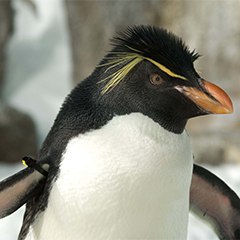
The southern rockhopper's species name, chrysocome, means "golden haired," a reference to the golden yellow crest feathers above its eyes.
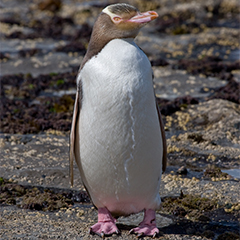
The yellow-eyed penguin, as its name suggests, has yellow eyes and a stripe of pale yellow feathers extending from the eye to the back of its head.
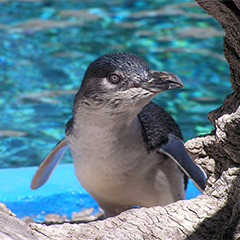
The little penguin, also known as the little blue, has slate-blue to black feathers and a white chin and chest.

Temperate penguins (genus Spheniscus), such as the Humboldt and Magellanic, have unfeathered fleshy areas on the face and one or two distinct black stripes across the chest.
Chicks, juveniles, and immature penguins may have slightly different markings than adults. Generally, they appear duller in color than adults. Adult markings take a year or longer to develop.
Sexual dimorphism
Generally, penguins are not sexually dimorphic: males and females look alike. Crested penguins are exceptions: the males are more robust and have larger bills than females.
When seen in pairs during breeding season, royal penguins are one of the easiest penguins species to visually identify males from females. Males have larger bills and white cheeks while females often have gray colored cheeks.
Flippers
Wings are modified into paddle-like flippers. The bones are flattened and broadened, with the joint of the elbow and wrist almost fused. This forms a tapered, flat flipper for swimming.
Each flipper is covered with short, scale-like feathers. The long wing feathers typical of most birds would be too flexible for swimming through water.
Instead of having wings like other birds, penguins have tapered, flattened flippers for swimming.
Penguins propel themselves through the water by flapping their flippers.
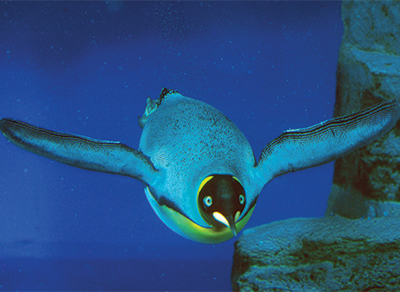
Head
Different species of penguins can be identified by their head and facial markings.
Penguins have a variety of bill shapes. A penguin captures fish, squid, and crustaceans with its bill.
- Generally, the bill tends to be long and thin in species that are primarily fish eaters, and shorter and stouter in those that mainly eat krill.
- The mouth is lined with horny, rear-directed spines to aid in swallowing live prey.
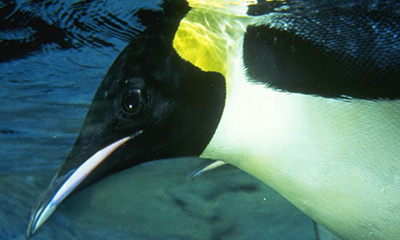
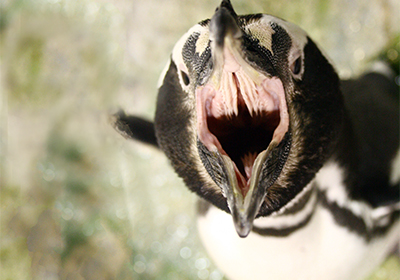
Eyes.
- The color of irises varies among the species.
- Many species have brown, reddish-brown, or golden-brown eyes.
- Rockhopper and macaroni penguins have red eyes.
- Fairy (little blue) penguins have bluish-gray eyes.
- As their name implies, yellow-eyed penguins have yellow eyes.
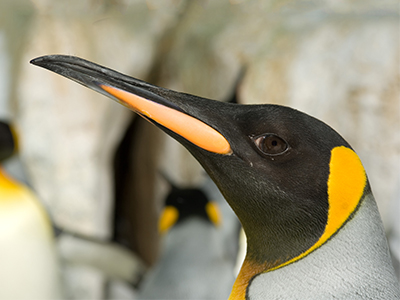
- Nearly all birds studied have circular pupils. Rare exceptions include the king and emperor penguins. The pupil of an emperor penguin becomes "diamond-shaped" when strongly constricted.
- A king penguin's normally circular pupil changes to small, square-shaped pinholes when constricted. A king penguin's pupil area can adjust from brightness to the darkness of the ocean as they dive to hunt. In fact, the area of their pupils can change an amazing 300-fold — more than any bird species known.
- Like other birds, penguins have a nictitating membrane, sometimes called a third eyelid. This is a clear covering that protects the eye from injury.
Legs & Feet
Penguin legs are short and strong. Feet are webbed, with visible claws. The legs are set far back on the body to aid in streamlining and steering while swimming. This placement also causes penguins to stand vertically and walk upright.

Gentoo feet
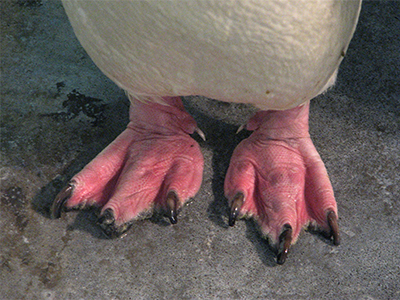
Macaroni feet

Magellanic feet
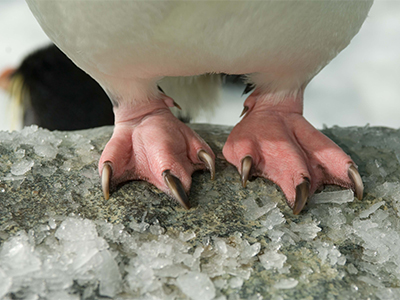
Rockhopper feet
Penguins walk with short steps or hops, sometimes using their bills or tails to assist themselves on steep climbs.
- The maximum walking speed for Adélie penguins is 3.9 kph (2.4 mph.)
- Emperor and king penguins walk slowly and do not hop.
- Some species, like the rockhopper penguins, jump from rock to rock.
When traveling on ice, Antarctic penguins often "toboggan" on their bellies. They use their flippers and feet to slide their bodies forward along the ice.
Tail
A penguin's tail is short, and wedge-shaped, with 14 to 18 stiff tail feathers. Adélie, gentoo, and chinstrap penguins (collectively known as brush-tailed penguins) have longer tail feathers, which they often use as a prop when on land.

Feathers
Shiny feathers uniformly overlap to cover a penguin's skin. Penguin feathers are highly specialized. They are short, broad, and closely spaced. This helps keep water away from the skin. Tufts of down on the feather shafts increase the insulative properties of the feathers.

Penguins have more feathers than most other birds, with about 100 feathers per square inch.
Most penguin species go through one complete molt (shed their feathers) each year, usually after the breeding season. The exception is the Galápagos penguin, which usually goes through two molts per year.
- Molting is essential because feathers wear out during the year. Feathers become worn when penguins rub against each other, come in contact with the ground and water, and regularly preen (clean, rearrange, and oil) their feathers.
- The new feather grows under the old one, pushing it out. The old feather does not fall out until the new one is completely in place. The molt is patchy and can give individual penguins a scruffy look.
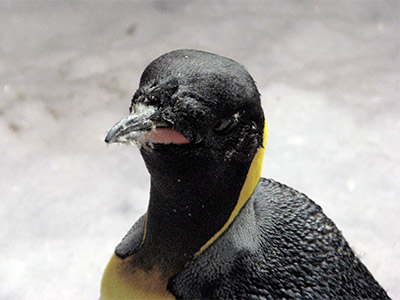
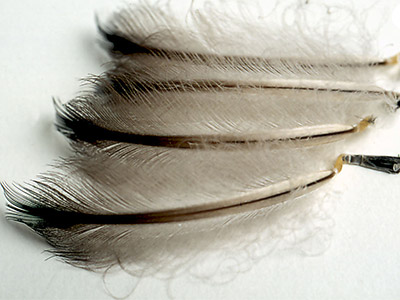
- During the molt, feathers lose some of their insulating and waterproofing capabilities, and penguins stay out of the water until their plumage is restored to optimal condition.
- Depending on the species, the average length of the molt varies from 13 days for the Galápagos penguin to 34 days for the emperor penguin.
- Penguins fast when molting. Prior to this, they each build up a thick layer of fat to provide energy until the molt is complete.



